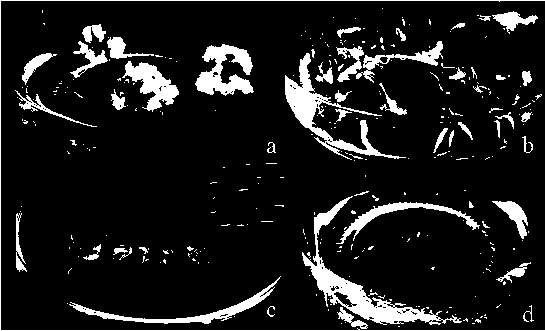Ultralow-temperature preservation method for stem tips of wild rice
A technology of ultra-low temperature preservation and rice strips, which is applied in the field of plant cell engineering, can solve problems such as difficult to obtain materials, damage to shoot tip growth points, and difficult to cultivate, so as to reduce the difficulty of operation, simplify the operation process and processing time, and facilitate large-scale production saved effect
- Summary
- Abstract
- Description
- Claims
- Application Information
AI Technical Summary
Problems solved by technology
Method used
Image
Examples
Embodiment 1
[0023] Embodiment 1, the disinfection of wild rice and the processing of breaking dormancy
[0024] Take wild rice seeds, sterilize with 70% alcohol for 1 min, 0.1% sodium hypochlorite for 15 min, rinse with sterile water several times, and wash with 5% PEG, 200 mgL -1 GA 3 Soak the seeds in MS liquid medium for 2 days at room temperature in the dark.
Embodiment 2
[0025] Embodiment 2, the embryogenic callus induction of wild rice
[0026] Get the processed seed of embodiment 1, inoculate and contain 6-BA0.5mgL -1 , 2,4-D 2mgL -1 The callus was induced in MS medium, cultured at 25±2°C, and cultured in the dark. White granular callus can be seen in about 20 days, which is stripped from the seeds, transferred to a new medium, and subcultured once every 10-20 days;
Embodiment 3
[0027] Embodiment 3, wild rice cluster bud induction and rooting culture
[0028] Get the embryogenic callus that embodiment 2 obtains, put into containing 6-BA0.5mgL -1 , NAA0.1mgL -1 In MS medium, culture temperature is 25±2℃, light is 12 h·d -1 , light intensity 36 µmol m -2 the s -1 , About 10-15 days to induce callus containing 2-3mm clustered shoots. Take clustered shoots of 2-3mm, cut off the base disc callus, and inoculate the buds one by one with NAA0.1mgL -1 In MS medium, new roots of 1-2mm were induced in about 3-5 days.
PUM
 Login to View More
Login to View More Abstract
Description
Claims
Application Information
 Login to View More
Login to View More - R&D
- Intellectual Property
- Life Sciences
- Materials
- Tech Scout
- Unparalleled Data Quality
- Higher Quality Content
- 60% Fewer Hallucinations
Browse by: Latest US Patents, China's latest patents, Technical Efficacy Thesaurus, Application Domain, Technology Topic, Popular Technical Reports.
© 2025 PatSnap. All rights reserved.Legal|Privacy policy|Modern Slavery Act Transparency Statement|Sitemap|About US| Contact US: help@patsnap.com


